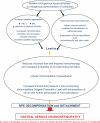Central serous chorioretinopathy: a pathogenetic model
- PMID: 21386917
- PMCID: PMC3046994
- DOI: 10.2147/OPTH.S17182
Central serous chorioretinopathy: a pathogenetic model
Abstract
Despite numerous studies describing predominantly its demography and clinical course, many aspects of central serous chorioretinopathy (CSCR) remain unclear. Perhaps the major impediment to finding an effective therapy is the difficulty of performing studies with large enough cohorts, which has meant that clinicians have focused more on therapy than on a deeper understanding of the pathogenesis of the disease. Hypotheses on the pathogenesis of CSCR have ranged from a basic alteration in the choroid to an involvement of the retinal pigment epithelium (RPE). Starting from evidence that affected subjects often present a personality prone to stress with altered pituitary-hypothalamic axis response (HPA) and that they have higher levels of serum and urinary cortisol and catecholamines than healthy subjects, we hypothesize a cascade of events that may lead to CSCR through hypercoagulability and augmented platelet aggregation. In particular we investigated the role of tissue plasminogen activator, increasing plasminogen activator inhibitor 1 (PAI-1), and plasmin-α2- plasmin inhibitor complexes. We reviewed the different therapeutic approaches, including adrenergic antagonists, carbonic anhydrase inhibitors, mifepristone, ketoconazole, laser photocoagulation, intravitreal injection of bevacizumab, and photodynamic therapy with verteporfin (PDT) and our model of pathogenesis seems to be in agreement with the clinical effects obtained from these treatments. In accord with our thesis, we began to treat a group of patients affected by CSCR with low-dose aspirin (75-100 mg), because of its effectiveness in other vascular diseases and its low ocular and general toxicity with prolonged use. The formulation of a causative model of CSCR enables us to understand how the therapeutic approach cannot be based on a generalized therapy but should be individualized for each patient, and that sometimes a combined strategy of treatment is required. Moreover a complete knowledge of the disease will help to identify patients prone to the most persistent forms of CSCR, and thus help to find a treatment.
Keywords: CSCR; PAI-1; aspirin; glucocorticoid; macula; pathogenesis.
Figures
References
-
- Von Graefe A. Ueber centrale recidivirende Retinitis. Albrecht von Graefe’s Arch Klin Ophthalmol. 1866;12:211.
-
- Horniker E. Ueber eine Form von zentraler Retinitis auf angioneurotischer Grundlage [Retinitis centralis angioneurotica] Albrecht von Graefe’s Arch Klin Ophthalmol. 1930;123:286.
-
- Gass JDM. Pathogenesis of disciform detachment of the neuroepithelium. Am J Ophthalmol. 1967;63:587. - PubMed
-
- Wang M, Munch CI, Hasler PW, Prunte C, Larsen M. Central serous chorioretinopathy. Acta Ophthalmol. 2008;86:126–145. - PubMed
-
- Klein ML, van Buskirk ME, Friedman E, Gragoudas E, Chandra S. Experience with nontreatment of central serous choroidopathy. Arch Ophthalmol. 1974;91:247–250. - PubMed
LinkOut - more resources
Full Text Sources
Miscellaneous


